
How To Grow Melons
Few fruits offer the delicious, sweet flavours and aromas of melons, so why not grow them yourself? If you've always bought melons from your local store, we're here to tell you that cultivating them couldn't be simpler. Don't believe us? Read on to find out all you need to know, as well as some of the best varieties to try.
Bursting with sweet and refreshing flavours, there's no doubting the appeal of melons. Whether eaten at breakfast or as a snack, this fruit is in high demand. However, have you ever considered growing these beauties yourself? You might think it's a tall order, but we're here to tell you it's anything but! As long as you have sufficient space, you can easily cultivate your very own supply of melons. Here’s how!
When and how to sow melon seeds
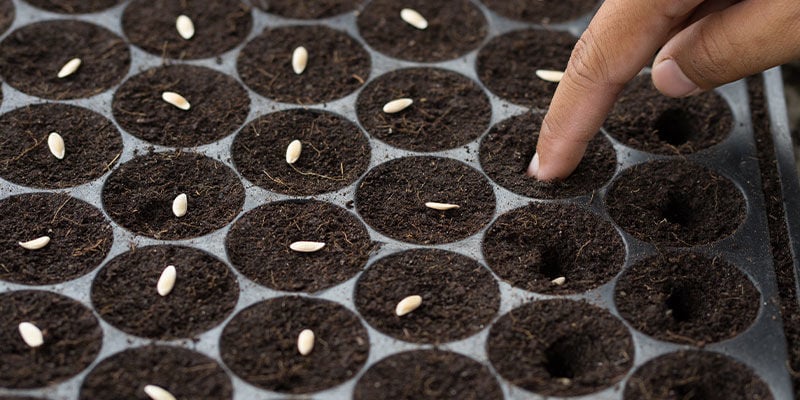
There are a few schools of thought regarding sowing your melon seeds. Although we'll get into more detail later about different melon varieties, as a rule of thumb, growers should opt for cantaloupe seeds if planting under cold frames or cloches. If using a greenhouse, however, you have a wider choice of melons to choose from, such as honeydew and watermelon. Once you've considered the type of melon you wish to grow, it's time to get sowing.
Typically, melon seeds are started off indoors where conditions and temperatures are consistent. A heated propagator can be a useful tool here, but isn’t necessary. Start by filling 9cm pots filled with compost. Sow two seeds per container and keep them in a well-lit position with a consistent temperature of around 18°C. The sowing process should be undertaken in mid-to-late April with the goal of moving the seedlings outdoors come late spring/early summer.
Caring for your melon plants
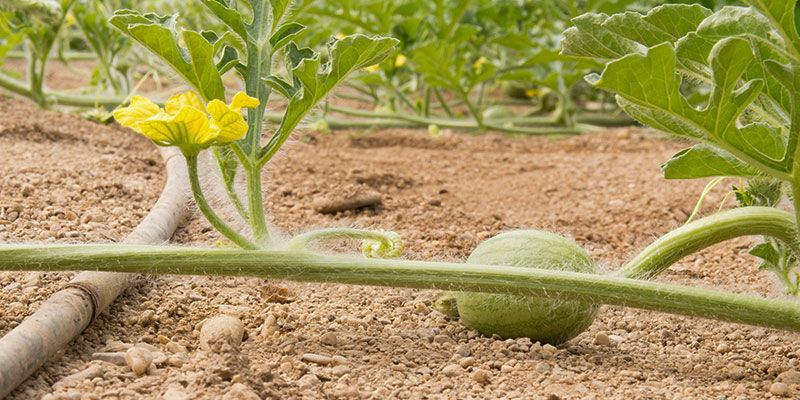
When it comes to caring for your melon plants, you're in for a relatively easy ride. In this section, we'll cover everything you need to know about maintaining your plants so you can fully enjoy the fruits of your labour.
Transplanting
When it comes to transplanting your seedlings, there are a few factors to consider. The reason we suggest planting two seeds per container is so you get two attempts at growing the perfect seedling. Essentially, one seedling will inevitably grow weaker than the other, so remove this one, and ensure that the compost is kept moist until ready to transplant outdoors.
When late spring/early summer rolls around, it's time to get your plants outdoors to soak up the sun. Transplant your seedlings into 45cm pots filled with compost. However, if you prefer to use growing bags, you can plant up to two seedlings.
Pinching out
Once plants have been positioned in their new containers, they will begin to put their energy into promoting more leaves. As soon as your plants have five leaves, pinch out the tips to promote side shoot growth. Once these side shoots appear, you have the choice of growing them using bamboo supports or letting them trail along the ground, depending on your setup.
Watering and feeding
Melon plants are pretty low-maintenance, and this sentiment extends to their watering and feeding requirements. Ensure that the surrounding substrate is kept moist but not waterlogged. Also, be careful that water doesn't pool around the base of the stem, as this can lead to issues such as rotting. As a rule of thumb, give plants around an inch or two (2.5–5cm) of water per week. In terms of feeding, provide your melon plants with a dedicated liquid fertiliser every two to three weeks, but be sure to follow the instructions as overfeeding can also lead to some serious plant ailments!
When and how to harvest
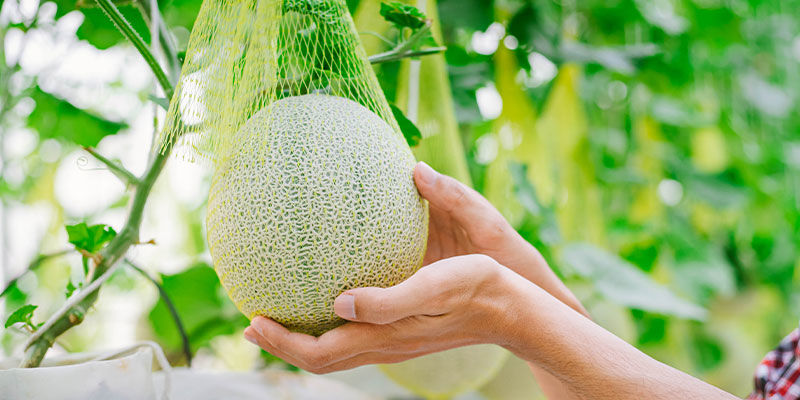
But how will you know when your melons are ready to harvest? In this section, we'll show you some surefire ways to recognise your melons are ripe and ready to go. Of course, this will vary slightly from variety to variety, so be sure to reference your seed packet instructions for extra clarity.
How to tell a melon is ripe
Late summer is the time when your melon plants will reach their point of harvest. The beauty of growing these plants (as well as any fruit) is that you can visually track their health and progress. So not only will your melons reach the optimal size, but you'll also notice cracking near the stem of the plant.
However, it's not just their appearance that will let you know they're ready. In fact, the aroma is the perfect signal that they're ready to enjoy. If you can smell the melon scent through the skin, you're good to go. Grab a clean knife or garden pruners and cut away about an inch (~2.5cm) up the stem.
Melon varieties to check out
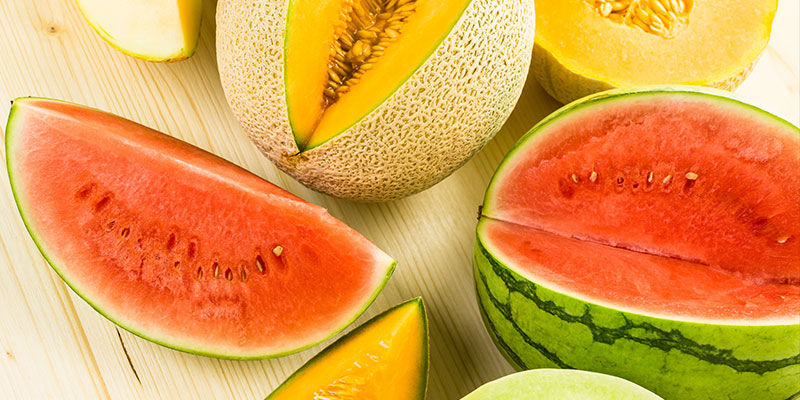
So, now that you know what's expected from the melon growing process, which variety (or varieties!) will you choose to cultivate? Here we've selected three melons that will bring great flavour and sizeable yields to your grow operation.
Watermelon
What can we say about the classic watermelon? This massively popular variety makes for the perfect refreshing summer snack, breakfast treat, or after-dinner fruit salad; the applications are endless. Get these seeds started in March/April, and you'll enjoy delicious watermelon in the later months of the year. While they require a little bit more of a hands-on approach compared to other melon varieties, there's no denying that the end justifies the means!
Cantaloupe “Charentais”
The Charentais makes for the perfect melon for newcomers and the experienced alike. Much like the other varieties mentioned here, these seeds can be started indoors or in a greenhouse between the months of March and May, then positioned outdoors to flourish throughout the summer months. Just be sure to keep them well-watered, and you will enjoy sweet melons for a long time to come.
Muskmelon
No, this isn't some invention by a particular South African billionaire; the muskmelon is an aromatic, sweet, juicy fruit ideal for growing at home. Ensure plants are spaced at least 30cm apart, and you can't go wrong. As soon as the skin changes colour, you'll know you're about to be in sweet melon heaven. Sow seeds in April and let this plant thrive throughout the rest of the year.
No need to be melon-choly
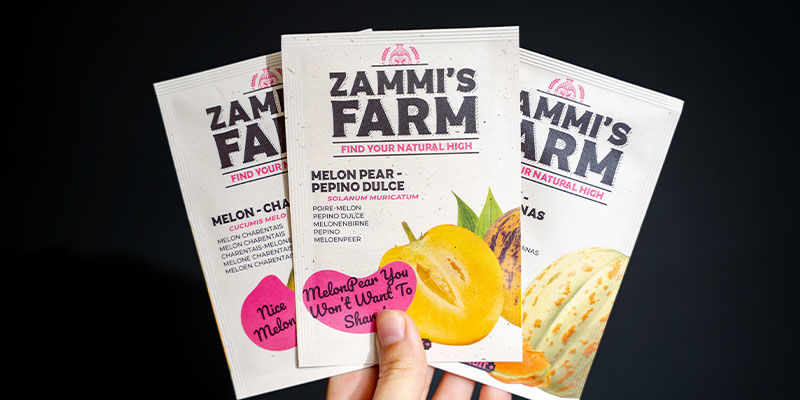
There's never been a better time to enjoy sweet and delicious melons. The best part is knowing that you grew them yourself, so they'll taste just that little bit sweeter! If we've got your mouth watering at the very thought, head over to the Zamnesia store today for your pick of the best melon seeds, and get your growing project off the ground!
-
 3 min
19 October 2023
Top 10 Plants For Butterflies
Have you ever wanted to attract some butterflies to your garden? Well, now you can. In this article, we delve into ten plant varieties that are sure to bring in the winged beauties. Not only will...
3 min
19 October 2023
Top 10 Plants For Butterflies
Have you ever wanted to attract some butterflies to your garden? Well, now you can. In this article, we delve into ten plant varieties that are sure to bring in the winged beauties. Not only will...
-
 5 min
3 August 2023
Top 10 Fruits To Grow At Home
Why bother heading to your local grocery shop when you can grow all of your favourite fruits at home? Whether you're in an apartment with a small balcony or staring out over acres of land, you'll...
5 min
3 August 2023
Top 10 Fruits To Grow At Home
Why bother heading to your local grocery shop when you can grow all of your favourite fruits at home? Whether you're in an apartment with a small balcony or staring out over acres of land, you'll...
-
 5 min
5 September 2022
How To Overwinter Pepper Plants
Overwintering your chilli plants keeps them alive for another season, increasing yield and growth speed come next harvest. A fascinating process with great results, learn how to overwinter pepper...
5 min
5 September 2022
How To Overwinter Pepper Plants
Overwintering your chilli plants keeps them alive for another season, increasing yield and growth speed come next harvest. A fascinating process with great results, learn how to overwinter pepper...
-
 6 min
12 April 2022
How To Transplant Hot Pepper Plants
Growing chili plants is highly rewarding and, if done right, can produce bountiful harvests of tasty hot peppers. Transplanting is a crucial skill when it comes to chili cultivation, and we're here...
6 min
12 April 2022
How To Transplant Hot Pepper Plants
Growing chili plants is highly rewarding and, if done right, can produce bountiful harvests of tasty hot peppers. Transplanting is a crucial skill when it comes to chili cultivation, and we're here...






 United States
United States











